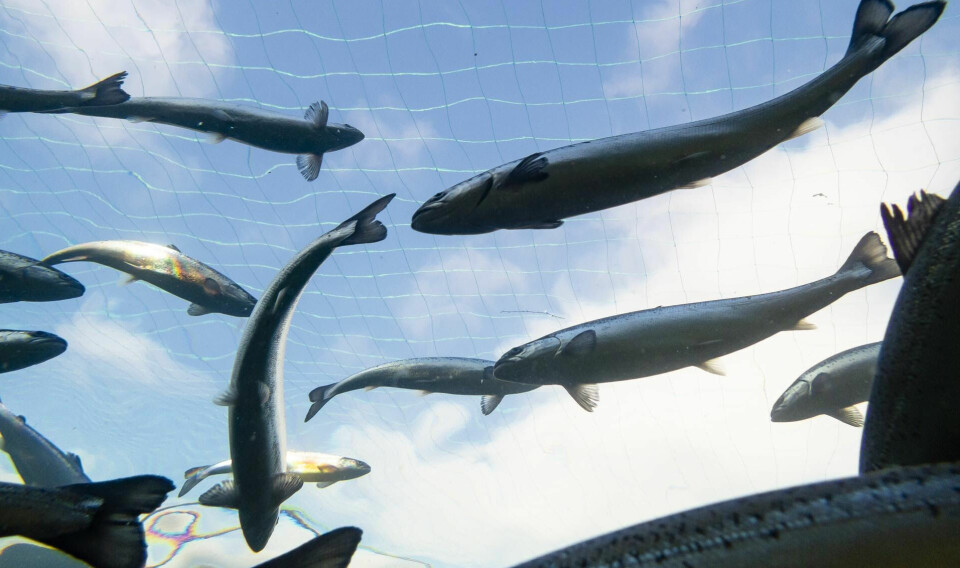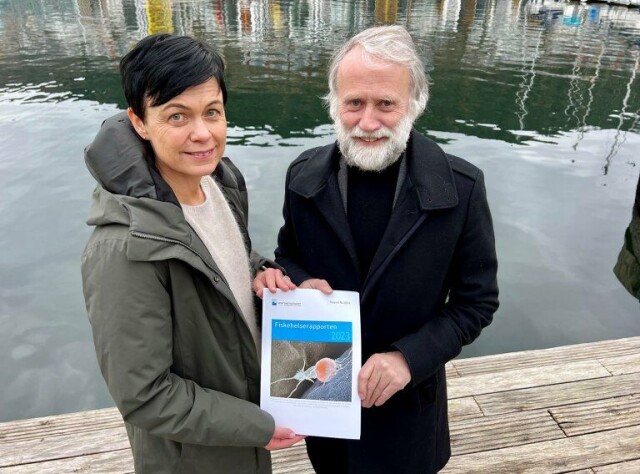

Norway’s fish health report 2023: what killed nearly 17% of farmed salmon
Infectious diseases were the most significant cause of mortality in Norwegian fish farming last year. In 2023, 62.8 million salmon (16.7%) and 2.5 million rainbow trout (14%) died in the marine phase of production.
For the first time, the annual fish health report produced by the Norwegian Veterinary Institute can show an overview of the main categories of causes of death for farmed salmon. The farming companies themselves have shared data about this in the industry initiative AquaCloud.
The main causes of mortality registered at national level were “Infectious diseases” with approximately 38%, “Injuries (trauma)” with approximately 33% and “Unknown cause” with around 20%. “Physiological causes” were blamed for 4.5% of mortality, “Environmental conditions” for 2.9%, and “Other causes” for 2%. In 2023, there were 355 localities producing salmon that participated in the initiative, corresponding to 43% of standing mass in the sea.
“Infectious diseases are an extensive problem both for the fish’s welfare and survival in the sea. There is a lot of knowledge about how the risk of infection can be reduced and there is great potential for improvement. It requires that the knowledge is used and translated into action in the farming industry,” said Edgar Brun, department director at the Veterinary Institute.
Strong data base
Ingunn Sommerset, editor of the Fish Health Report, said: “This year’s report has a strengthened data base. We see that the six mortality categories in which the industry itself has registered mortality coincide and strengthen our own surveys. We now have a good factual base from which industry and administration can work to solve the challenges.”
The five most common subcategories in “Infectious diseases” were winter sores, cardiomyopathy syndrome (CMS), gill disease, heart and skeletal muscle inflammation (HSMI) and pasteurellosis. Lice treatments and stressful handling can weaken the fish and make it more susceptible to infectious diseases.
Mortality at sea
62.8 million salmon (16.7%) and 2.5 million rainbow trout (14%) died in the sea phase of production in 2023. For salmon in the sea phase, the mortality figures, both in number and percentage, are the highest recorded so far. As in previous years, there are large geographical differences in mortality. For food fish salmon in 2023, production area 3 (PO3) comes out worst with 25%, followed by PO2 with 22%, while PO13, PO1 and PO11 all have below 10% mortality. Norway has 13 salmon production areas, from PO1 in the south to PO13 in the far north.
The number of dead hatchery fish (over 3 grams) was reported in 2023 to be 37.7 million salmon and 2.4 million rainbow trout. This is an increase of approximately 2 million salmon compared to 2022. For rainbow trout, there is a slight decrease in both reported dead fish numbers and stocking numbers. The way the data are reported makes it difficult to calculate the annual percentage mortality in the hatchery phase.
Part of the Fish Health Report’s data base is a survey among
fish health personnel. Three health problems stand out in 2023, as they did in
2022: Damage from delousing operations, complex gill disease, and winter sores.
A significant change from previous years is that damage caused by jellyfish is
ranked among the 10 most important health challenges.
Notifiable diseases
Infectious salmon anaemia (ISA) was confirmed in 2023 at 18 locations. In addition, ISA was suspected at a further five locations. A significant proportion of outbreaks and suspicions were in Western Norway.
There has been a decrease in the number of cases of pancreas disease (PD) in recent years, and in 2023 there was a further reduction to a total of 58 cases, compared to 98 cases in 2022. Four PD outbreaks caused by salmonid alphavirus 2 (SAV2) on the Helgeland coast last autumn is, however, serious. It has not been confirmed how the infection was introduced to Helgeland. Rapid emptying of the locations with PD has hopefully prevented further spread of infection.
Bacterial kidney disease (BKD) caused by Renibacterium salmoninarum saw an upswing in 2023. Most of the detections were in PO6, where it is suspected that the infection spread through the transport of infected fish and/or via wellboats. The bacteria can also be transmitted via infected roe, and there are no effective vaccines or drugs against BKD.
Non-notifiable diseases
Over the past four years, a number of farming companies have contributed data on cases of non-reportable diseases via private diagnostic laboratories. The factual basis for national disease status has thus been strengthened in recent years.
The viral diseases cardiomyopathy syndrome (CMS) and heart and skeletal muscle inflammation (HSMI) are among the most frequently detected diseases in salmon in the marine phase and both can be associated with increased mortality following handling-intensive salmon lice treatment. In 2023, CMS was detected in approximately the same number of locations as in 2022. HSMI was detected in approximately the same number of locations as in 2021 after an apparent decrease in 2022. For infectious pancreatic necrosis (IPN), the situation is stable with a low incidence.
Overall, winter sores are perhaps the biggest health and welfare challenge linked to bacterial infection in Norwegian farmed salmon at sea. The number of localities with proven infection with Moritella viscosa (classic winter sore) was 320 in 2023, compared to 296 in 2022. The number of localities with proven infection with Tenacibaculum spp (tenacibaculosis/atypical winter sore) was 155 in 2023 and 205 in 2022.
The number of detections of Yersinia ruckeri, which causes yersiniosis, continued to increase also in 2023. A high and increasing number of requested doses of injection vaccine against yersiniosis indicates that there are significant problems with the disease. However, an effect of increased vaccine coverage will only be seen when vaccinated fish are stocked.
The pasteurellosis epidemic that has been going on in farmed salmon in Western Norway since 2018 also continued in 2023, but the number of cases almost halved compared to 2022.
Salmon lice
Salmon lice are still the biggest parasite challenge and the driver of disease in farmed salmon in the sea in Norway. The lice levels in 2023 were somewhat lower than in 2022. In 2023, most of the lice removals were drug-free; there was a 17% decrease in the number of such treatments from the previous year. The number of thermal treatments decreased by 24%. Mechanical lice removal was the most common lice removal method in 2023. The number of weeks of medicinal lice treatment remained approximately at the same level as in 2022.
More vaccination
Vaccination can be an important measure to reduce infection. New in this year’s report is a separate chapter on “Biosafety” which includes, among other things, statistics on vaccines with marketing authorisation for farmed fish in Norway. The statistics, as well as information from the survey, show that vaccination is increasingly used against ISA and PD, but also against non-notifiable diseases such as yersiniosis, winter sores and pasteurellosis.
Wild fish and foreign species
Humpback salmon is an alien fish species with a natural distribution in the Pacific Ocean but has spread to both sides of the northern Atlantic Ocean after extensive stocking in Russia. Humpback salmon have a strict two-year life cycle, and in 2023 there was a new invasion in Norway with control measures and a recorded catch of 364,000 humpback salmon. The Norwegian Veterinary Institute’s health monitoring in 2023 did not detect any serious notifiable fish diseases in examined humpback salmon.
Read the Fish Health Report for 2023 here (translation required).






















































